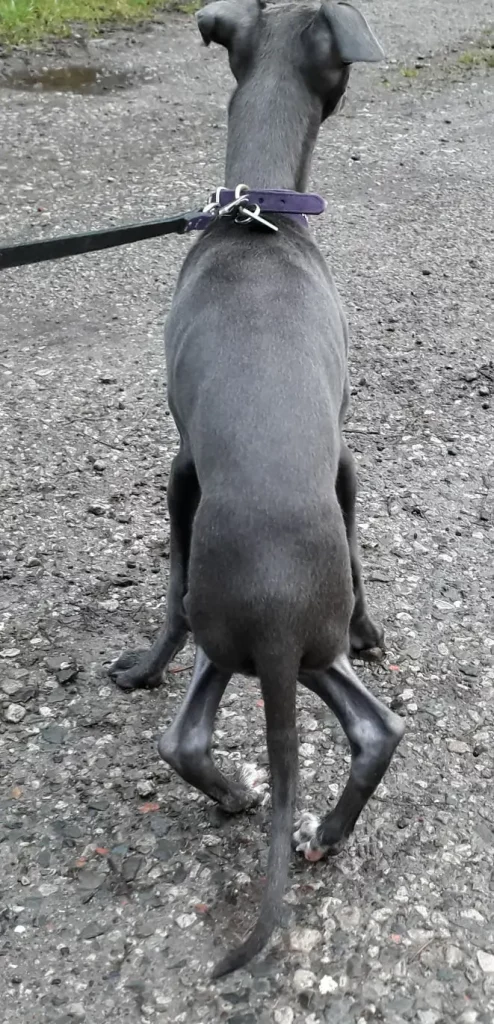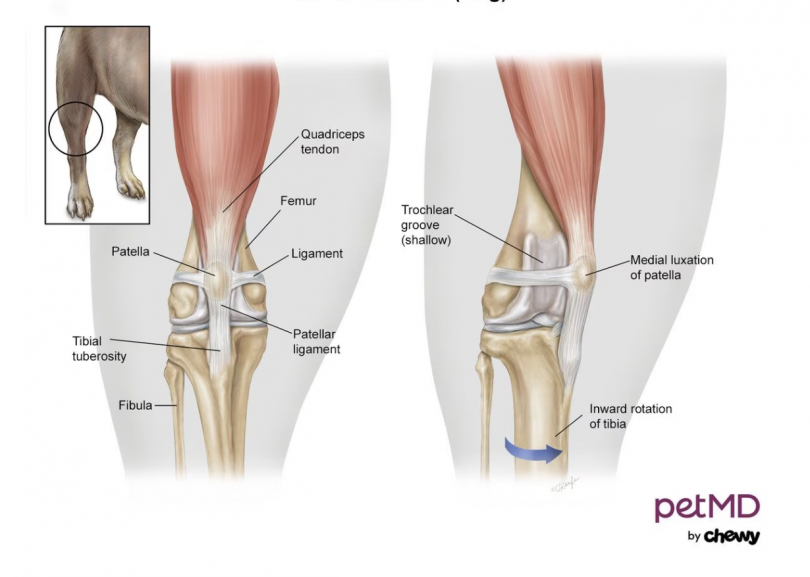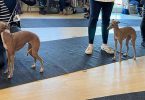The patella is another name for the kneecap, which is a thick, triangular-shaped bone that protects the knee joint. In an Italian Greyhound with normal knees, the patella sits in a groove and rides up and down as the leg bends and stretches. With patella luxation, the kneecap is prone to slipping in the groove and may even completely pop out of place.
There are four grades of patellar luxations, and most dogs suffer from grade 1 or 2. In severe cases (grade 3 or 4), the patella slips out permanently and causes a dog to walk with inward-bent legs or prevents the dog from using the affected leg(s) entirely.

Patella Luxation Grades
| Grade | Symptoms | Treatment |
|---|---|---|
| Grade 1 | The knee can be manually moved out of its groove upon veterinary examination but pops back in by itself. | If caught early, can be treated with physiotherapy and hydrotherapy to build up muscle to hold the knee in place. |
| Grade 2 | The knee can be manually moved out of its groove or will spontaneously pop out as the leg is manipulated. It does not immediately pop back into place and must either be pushed back into place or popped back in by stretching the dog’s leg. | If caught early, can be treated with physiotherapy and hydrotherapy to build up muscle to hold the knee in place. If the condition is not treated, the knee will deteriorate and ultimately, surgery will be required. |
| Grade 3 | The kneecap spends most of the time out of its groove but can be manually pushed back in. Any stretching or bending of the dog’s leg causes the knee to pop out. | Requires surgery to improve the groove of the knee and to realign the tendons that attach it. |
| Grade 4 | The kneecap is permanently out of its groove and cannot be replaced with manual manipulation. The groove is so shallow that the patella has nothing to sit in. | Requires surgery to improve the groove of the knee and to realign the tendons that attach it. |
How Much Pain Does a Luxation Cause?
The answer to this question is complicated, as it depends on the grade of the problem and whether the IG has had treatment for the condition.
Grade 1
In grade 1, the kneecap slips in the groove but does not necessarily pop completely out. This slipping does not initially cause pain as the knee is cushioned with cartilage (which has no nerve endings). However, every time the patella slips, it scrapes away a tiny piece of cartilage. Over time, it wears it away completely and then the kneecap rubs against the underlying bone. At this stage, the problem becomes incredibly painful, and the dog will limp and may even refuse to place the affected leg on the ground. Any movement of the knee hurts, and the only recourse at this stage is surgery and pain management.
Grade 2
In grade 2, the kneecap will spontaneously pop, causing severe pain until it is replaced. In humans who have experienced this condition, they have described the popping of the knee as “agony”. The first time the knee pops, it will be difficult to replace. With each subsequent displacement, the tendons loosen, and while this means the knee pops back quicker, in turn, this makes it easier for it to come out again. Ultimately, every time the knee pops, damage is being done to the knee joint, leading to further issues.
Grade 3 and 4
In grade 3 and 4, the knee is rarely in the groove. This condition is often noticeable from birth and causes a puppy to struggle to use its back legs. How much pain this causes the dog is difficult to determine. However, the unnatural position of the knee puts pressure on the bones of the leg and spine and also the other ligaments in the joint. The affected dog is likely in constant pain but has learned to adapt due to the problem being present from birth.
Even with grade 1 luxations, if nothing is done to stop the knee from slipping, then arthritis will eventually form in the knees. Arthritis cannot be cured and will require long-term pain management. With all grades, there can be issues with pain in the lower back or in the leg muscles, including a condition similar to sciatica in humans due to the abnormal strain being placed on the joints.
How Do I Know If My Dog Has a Luxating Patella?
Grade 3 and 4 luxations are typically obvious from birth as the IG will not be able to walk normally on its back legs. With grade 4, the problem is so severe that the puppy may struggle to learn to walk at all and the hind legs will bow (with the paws touching). In grade 3, the IG walks but has a strange gait—sometimes stumbling or appearing to be unbalanced. The problem will worsen rapidly.
Can I Prevent a Luxating Patella?

Many owners want to know how to prevent patellar luxations, but the condition is often genetic (conformity issues)—due to a defect in the way the hind limbs form—or injury-related. The only way to prevent it from occurring is for breeders to breed animals who have sound knees. This is not a complete guarantee that any puppy will be free of the condition. However, genetics is complicated, and there can be instances of the conformity issuing showing up in a line of dogs that has never before been affected.
A 4 month old Italian Greyhound with untreated Grade 4 Patella luxation. Note the elbows tuck in allowing the front feet to turn out to compensate for lack of hind leg strength. Surgery was the only option for this puppy to be able to live a pain free life, with the condition it inherited.
Responsible Breeding Will Reduce the Problem
If you are planning on breeding from your Italian Greyhound, and it shows any signs of a knee issue, have his or her knees checked first, this is easily done by asking your vet to examine your dog. If a patella problem is confirmed you should not breed from your Italian Greyhound.
If Patella Luxation is diagnosed
They can be painful and frustrating, they are not life-threatening. With correct treatment, your Italian Greyhound will live happily and comfortably for many years without issue. Most dogs will not require surgery, and if problems are recognised soon enough, steps can be taken to ensure the problem does not worsen or result in arthritis. So, don’t despair if your Italian Greyhound has been diagnosed with the condition, there is lots you can do for them to make them pain-free and able to enjoy running and playing for the rest of their lives.









